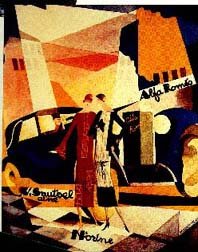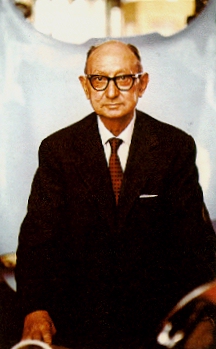Alfa Romeo Zagato Register & Information Site
Everything you ever wanted to know about Zagato.... and more!
The Zagato Company - Pre WW2
By Chris Koopmann
Pre-war history of Zagato Recently I read in the British magazine 'Classic and Sportscar' the following little anecdote: Once upon a time , long ago, a young Italian nobleman was taken to court by his relatives, who wished to prove he had gone mad. Their case was that he was no longer a fit person to control the family fortune, because he had wasted an absurd sum paying a local artisan to make a special aluminum body for his Alfa Romeo. The judge asked to be shown the car. On seeing it he immediately dismissed the case, declaring: | |
| "The search for beauty is the the most natural thing in man." |  |
| The artisan was Ugo Zagato, who founded the Carozzeria Zagato in Milano in April of 1919.
Ugo Zagato was born on 25th of June 1890 in Gavello, between Padova and Ferrara. Childhood was poor and at the age of 15 he had to leave his hometown in order to find work in Cologne/Germany in a little company specialized in metalworking. After his military service back in Italy he was hired as an apprentice by the Varesina bodyworks. Here he was exposed for the first time to concepts of car design - however still archaic or traditional derived from horse drawn carriages. At the age of 25 during the first World War Ugo Zagato moved to Torino in order to work with Pomilio, an aircraft construction company. In the next four years he learned everything which should become so important for his later car design: new sophisticated techniques of light and robust construction. | |
| "It's better to be a small boss than an important employee" | Ugo Zagato |
| With these words Ugo Zagato left the aircraft company at the peak of his career with the company. Not even the managing director was able to change his mind.
Being suddenly an entrepreneur rather than an employee, he started with five employees, relying on the 'old' construction principles, mainly modifying and improving 'ITALA' and 'DIATTO' sedans. The order books were full and the company moved to a larger site in 1923. In the same year the first son, Elio Zagato was born and the ties to Alfa Romeo strengthened - several RL were already bodied and the Alfa Romeo RLSS spiders were admired and successful cars. The second son, Gianni Zagato, was born in 1929. The breakthrough of the company came with the extremely successful Alfa Romeo types 1500 6C and 1750 6C a cooperation between Vittorio Jano, then manager of Alfa's car design department and Zagato. Both cars became a legend and drivers like Giuseppe Campari, Giulio Ramponi, Tazio Nuvolari or Enzo Ferrari, just to name a few won several races like the Mille Miglia on the Jano designed and Zagato bodied cars. Zagato was able to produce up to two cars per day during peak of demand and congested production space was always a problem as was financial situation due to the lack of administration. Nevertheless the 30's were very successful years for Zagato in terms of glory and international fame. In the 1938 Mille Miglia no less than 38 cars with Zagato bodies participated in the 750 cc and 1100 cc classes. Cooperation with other car manufacturers than Alfa Romeo included LANCIA, FIAT and ISOTTA FRASCHINI. During the war until August 1943, when the Zagato factory was destroyed by an air raid the company produced truck cabs. | |
